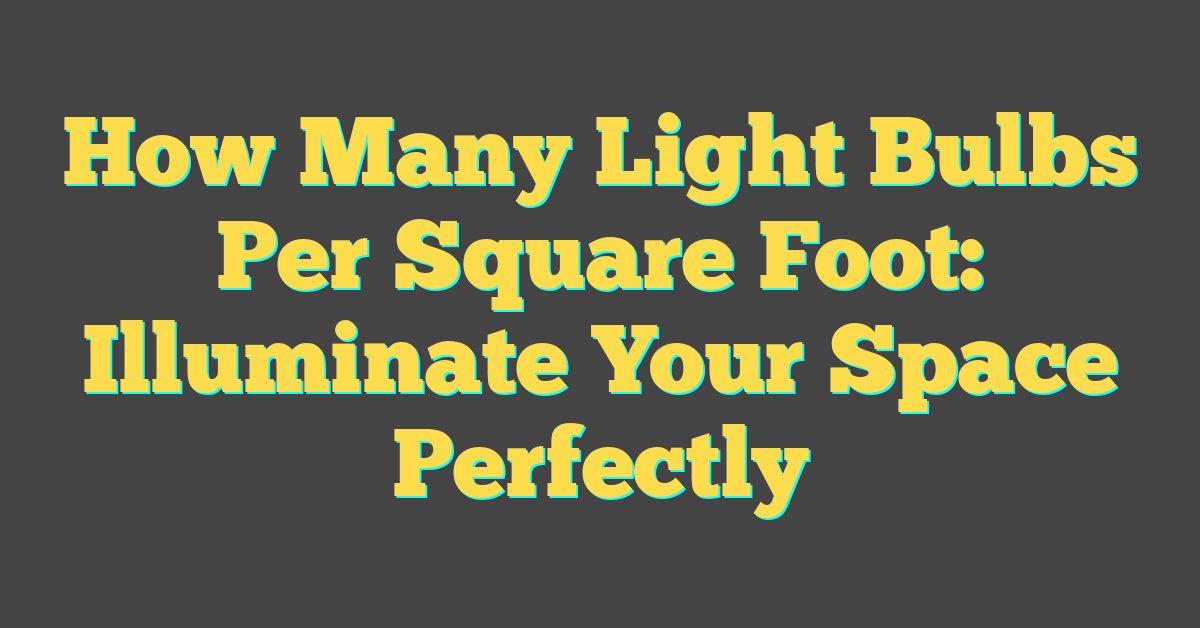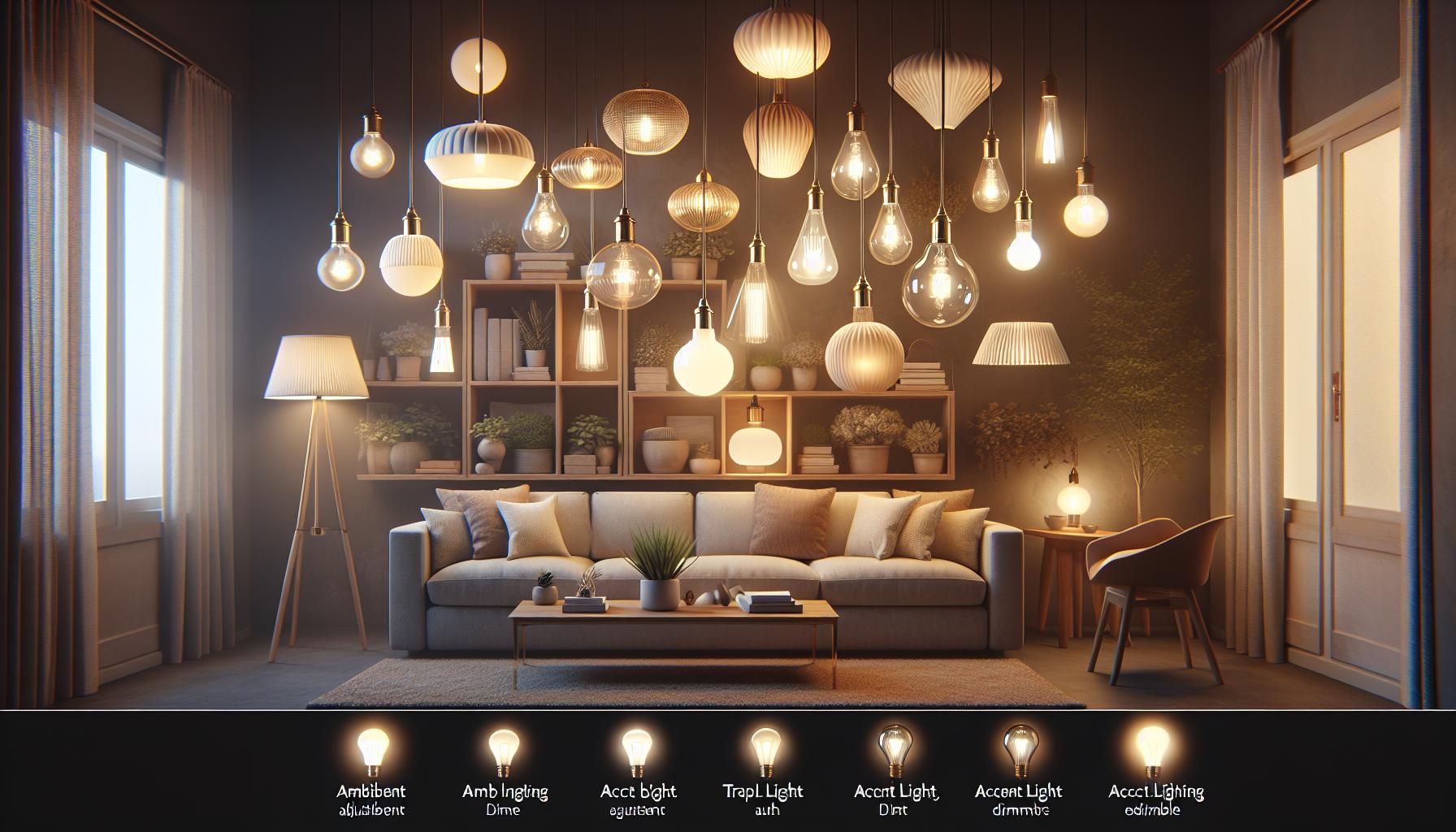Ever wondered how many light bulbs you need to perfectly illuminate your space? It’s not just about picking the brightest bulbs or the most energy-efficient options; it’s about the right number per square foot to ensure your room’s glowing just the way you want it.

Navigating the world of lumens, watts, and square footage can be a bit like trying to solve a puzzle in the dark. But don’t worry, you’re about to get all the pieces you need to light up your life, and yes, your rooms too.
Whether you’re setting up your home office, giving your kitchen a makeover, or just curious about optimizing your living room for that cozy feel, understanding the light bulb-to-square footage ratio is key. Let’s shed some light on the subject and make your lighting project a breeze.
Factors to Consider when Determining the Number of Light Bulbs
As you’re setting out to calculate how many light bulbs you’ll need per square foot, there are several factors you should take into account to ensure you get it just right.
Room Type and Purpose
Every room has its unique function, and the amount of light necessary can drastically vary. A home office might require more bright, focused light, whereas a dining area might benefit more from ambient, softer lighting. Here’s what you need to keep in mind for different spaces:
- Home Office: Adequate lighting to reduce eye strain.
- Kitchen: Brighter bulbs for task areas.
- Living Room: A combination of ambient and task lighting.
- Bedroom: Softer, calming lights.
Ceiling Height
Taller ceilings require bulbs with higher lumens since the light has farther to travel to illuminate the space below. You don’t want to end up with a dimly lit room because you didn’t account for your soaring ceilings!
Natural Light
If you have a room with generous windows that let in plenty of sunshine, you can often get away with fewer bulbs. But remember, as the sun sets, you’ll need sufficient artificial light to maintain visibility.
Decor and Wall Color
How many light bulbs per square foot you’ll need can also depend on your room’s decor and wall colors. Lighter walls reflect light better, potentially reducing the number of bulbs you need, whereas darker shades absorb light, which might require you to add more bulbs to reach the same level of brightness.
Bulb Type
With various bulb options available, choose the right one according to room’s needs – be it LED, incandescent, or fluorescent. LEDs are highly efficient and last longer, meaning they can be spaced further apart without sacrificing light output.
Keep these factors in your toolkit as you map out your lighting plan. With a little bit of know-how, you’ll bring each of your rooms to life with the perfect glow. And remember, experimenting with different bulbs and layouts can help you stumble upon the ideal lighting setup that’s both functional and inviting.
Understanding Lumens and Watts

When you’re selecting the right bulb for your space, it’s not just about the number of bulbs; lumens and watts are crucial to your lighting equation. Lumens measure the amount of light a bulb emits, basically its brightness, while watts indicate the energy a bulb uses. Here’s what you need to keep in mind:
Lumens: The Brightness Factor
Unlike the old days where wattage was mistakenly linked to brightness, today, lumens are the real indicator of how bright your bulb will shine. For a well-lit room, you typically need 20 lumens per square foot. However, don’t forget that your specific needs can vary based on room use and personal preference.
To give you a clearer picture:
| Room Type | Lumens per Square Foot |
|---|---|
| Living Room | 10-20 |
| Kitchen | 30-40 |
| Bedroom | 10-20 |
| Bathroom | 70-80 |
As you can see, areas where meticulous tasks are performed, like kitchens and bathrooms, demand more lumens.
Watts: Understanding Energy Consumption
« Can You Get Free Light Bulbs? How to Score Yours Today
What Light Bulbs Go in the Bathroom: Find Your Perfect Match »
Now onto watts – it’s all about efficiency. Watts tell you how much energy the bulb consumes, not how bright it’ll be. With advancements in LED technology, you can get the same brightness with significantly fewer watts. For instance, an LED bulb might give you the same brightness as a 60-watt incandescent bulb, but only use 10 watts of power.
- Incandescent bulbs: High wattage, less efficient
- LED bulbs: Low wattage, more efficient
Match your lumens to the task at hand and choose a wattage that aligns with your energy consumption goals. It’s a balancing act between brightness and energy usage. LED bulbs are your go-to for a significantly reduced energy bill and a bright, cozy atmosphere at home.
Consider your room’s unique needs, tweak and adjust. Embrace the art of DIY lighting—mix and match bulbs until you hit that sweet spot where everything looks just right.
Calculating the Lighting Requirements for different Room Sizes
Once you’ve got a grip on the desired brightness for various rooms as outlined by lumens per square foot, you’re ready to put that knowledge into action. Calculating the exact number of light bulbs you need for a space hinges on the room’s dimensions. Larger rooms obviously require more light sources, but there’s a bit of math involved to ensure accuracy.
Start by measuring the length and width of the room to get the total square footage. If you’re a whizz with DIY projects, you won’t break a sweat with this step. Grab your tape measure, jot down the numbers, and multiply the two together. Armed with this figure and the recommended lumens per square foot, you can calculate the total lumens required for your space.
Once you’ve got your total lumens, check out the lumens listed on bulb packaging. If you’re leaning towards LED bulbs—and why wouldn’t you be, considering their energy efficiency—you’re in luck because they list the lumens front and center.
Let’s look at an example. Say you’ve got a home office measuring 10 feet by 12 feet. That’s 120 square feet of passion for productivity. If the recommended lumens per square foot for an office is 70, you’ll need 8,400 lumens (120 sq ft x 70 lumens) to illuminate your workspace effectively.
Lastly, divide the total lumens needed by the lumens provided by an individual bulb. For instance, if one LED bulb gives off 800 lumens, you’ll need approximately 11 bulbs (8,400 / 800 = 10.5, rounded up because you can’t have half a bulb). It’s like a puzzle that feeds your love for all-things-lighting.
| Room Size (sq ft) | Recommended Lumens per Sq Ft | Total Lumens Needed | Lumens per LED Bulb | Number of Bulbs Needed |
|---|---|---|---|---|
| 120 | 70 | 8,400 | 800 | 11 |
Recommended Light Bulb per Square Foot Ratios

Now that you’re familiar with the basics of calculating your room’s lighting needs, it’s essential to understand the recommended light bulb per square foot ratios. These recommendations ensure that your space is neither too dim nor overwhelmingly bright, but just right.
For general living areas such as living rooms and dens, professionals advise aiming for a balance that supports a variety of activities. Imagine settling down with a good book or hosting friends for game night. You’ll need lighting that can adapt, which typically means about 20 lumens per square foot.
Kitchens and bathrooms demand more brightness for tasks like chopping vegetables or shaving. Therefore, these areas usually require a higher ratio. Industry standards recommend about 70 to 80 lumens per square foot in these functional spaces. It’s not just about seeing what you’re doing, it’s about creating a space that’s safe and usable.
Let’s not overlook hallways and storage areas. These are often forgotten, yet they also need proper illumination. For these parts of your home, a modest 5 to 10 lumens per square foot will usually suffice. It’s about ensuring you can navigate through your home without stumbling over that pair of shoes you left out.
Below is a quick reference table to help you gauge the lumens you’ll need based on the square footage of your room:
| Room Type | Lumens per Square Foot |
|---|---|
| Living Room/Den | 20 |
| Kitchen/Bathroom | 70-80 |
| Hallway/Storage | 5-10 |
Keeping these ratios in mind while selecting bulbs for each room will help maintain a harmonious and functional atmosphere throughout your home. Remember, it’s also vital to factor in natural light sources and the room’s color palette, as they play significant roles in the overall lighting effect. Brighter colors reflect light, reducing the need for additional bulbs, while darker colors absorb light, potentially requiring more lumens to achieve the same level of brightness.
So, when you’re on your next trip to the hardware store, list in hand and a clear goal in view, think lumens, not just watts. It’s not merely about the quantity of bulbs you use, but the quality of light they provide that will transform your house into a welcoming home.
Tips for Optimizing Lighting in Different Areas of the Home

When considering each room’s lighting needs, it’s not just about the lumens. You’ll want to tailor your approach to match the function and feel of each space in your home. Lighting can enhance mood, productivity, and even health, so take this seriously.
Layer Your Lighting
Think of lighting like a cake. Just as a cake has layers, so should your lighting plan. Use a mix of:
- Ambient lighting for overall illumination
- Task lighting for specific activities
- Accent lighting to highlight features or create atmosphere
This layered approach helps to evenly distribute light and can increase the functionality of the room.
Adjustability is Key
Invest in dimmer switches to give you control over the brightness of the room. Schedule changes, like the transition from day to night or different types of gatherings, demand varied lighting levels. If you’re working on a project in your home office, you may need brighter light than when you’re reading in bed.
Use Smart Bulbs for Convenience
Smart bulbs offer unparalleled convenience and customizability. You can adjust colors and temperatures to impact the feeling of the space. For your DIY projects, color-changing and programmable options can make the experience even more enjoyable. Pair them with smart home devices for an integrated experience.
Consider Natural Light
Remember to factor in natural light which changes throughout the day and with the seasons. Align your artificial lighting accordingly to provide a seamless transition and a comfortable environment. Position lighting to complement natural light sources, rather than compete with them.
Right Bulbs for Right Tasks
Choose different bulbs for different tasks. Cool white bulbs enhance concentration and are perfect for study areas or garages. Warm bulbs create a cozy ambiance suitable for living rooms or bedrooms. Don’t overlook the color rendering index (CRI) as well — bulbs with higher CRIs make colors pop, perfect for spaces where aesthetics are vital, like art studios or where you showcase decorative elements.
Don’t Forget Outdoor Lighting
Outdoor spaces need lighting too. Safety and security are the priorities, ensuring paths are well-lit and entryways are clear. However, outdoor lighting also has the power to transform a garden into a nighttime oasis — perfect for extending those DIY projects beyond the confines of the house.
Conclusion
So now you’ve got the lowdown on optimizing your home’s lighting. Remember, it’s not just about the number of bulbs but also where and how you use them. Whether you’re curling up with a book or hosting a dinner party, the right lighting can set the perfect mood. Don’t be afraid to experiment with dimmers and smart bulbs to find what works best for you. And let’s not forget the impact of basking in the glow of natural light. So go ahead, light up your space in a way that reflects your style and needs. Happy illuminating!
Frequently Asked Questions
What is the main focus of the article?
The article mainly focuses on how to optimize lighting in your home by matching the lighting approach to the function and feel of each space.
What lighting approach is recommended in the article?
The article recommends a layered lighting approach, which includes ambient lighting, task lighting, and accent lighting.
Why are dimmer switches suggested?
Dimmer switches are recommended for their ability to adjust lighting levels to suit different times of the day and various activities.
How can smart bulbs be beneficial?
Smart bulbs offer convenience and customizability, allowing users to control lighting remotely and personalize settings for individual needs.
What should be considered along with artificial lighting?
The article advises considering the interplay of natural light and aligning artificial lighting to complement it.
How should bulbs be chosen according to the article?
Bulbs should be chosen based on the specific tasks they will be used for, with different types of bulbs suited for different tasks.
Does the article address outdoor lighting?
Yes, the article also highlights the importance of not neglecting outdoor lighting in your home’s overall lighting plan.




